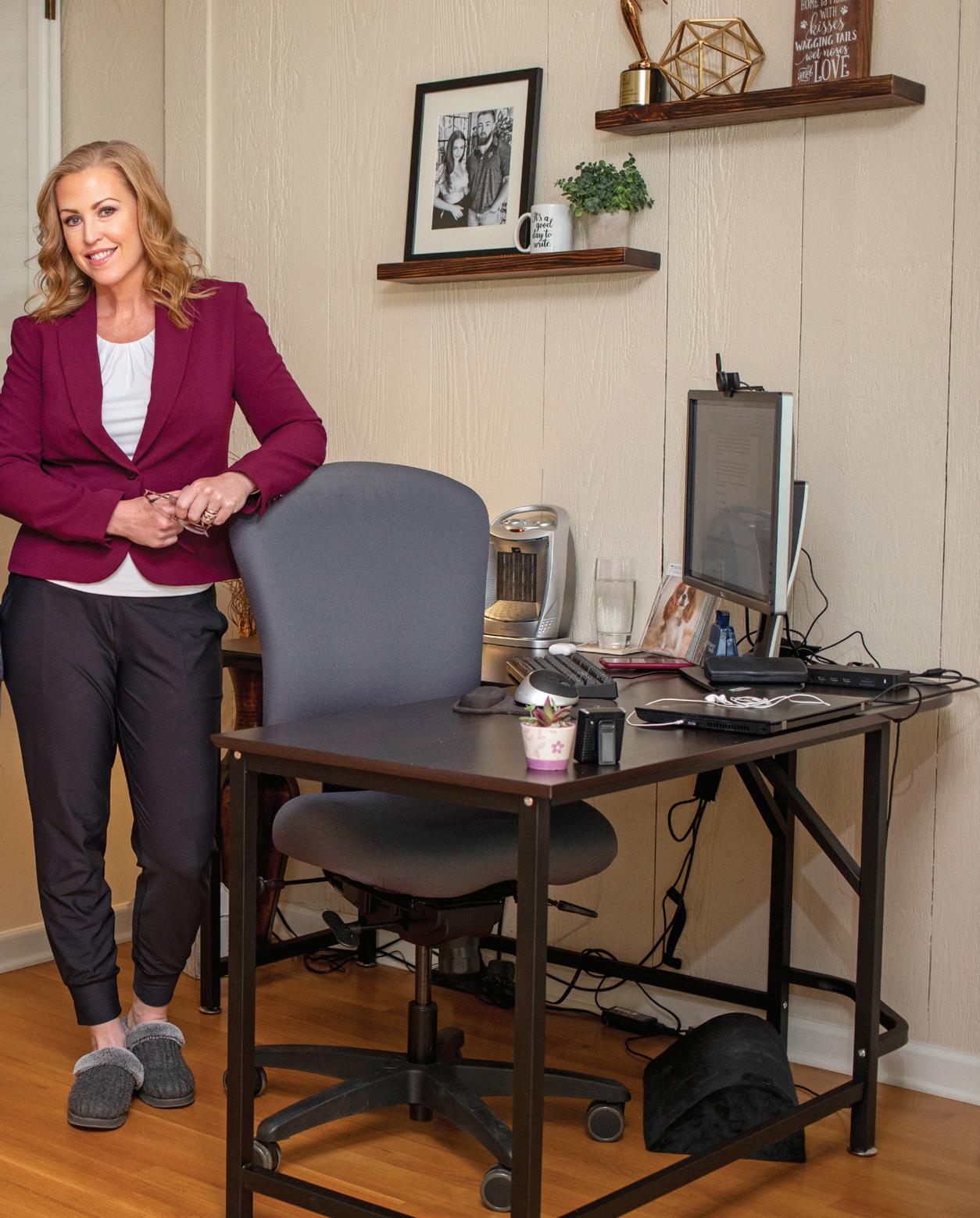
8 minute read
The Office, Then & Now
Two years in, the pandemic is permanently reshaping the traditional workspace concept
THE OFFICE, THEN & NOW
Advertisement
N EARLY 2020, with the entire world in a tailspin caused by the onslaught of the COVID-19 pandemic, Megan Brownell found herself facing a fairly inconceivable set of circumstances. Brownell—vice president of communications for Banner Health Foundation, the philanthropic, fund-raising arm of Banner Health— got word that her company’s midtown Phoenix offices were shutting down.
“It’s kind of marked in my memory that it was the Friday before St. Patrick’s Day, when we were asked, sort of casually, to tell our teams to take their laptops home that weekend because, as they said, they weren’t sure what the next week or couple of weeks were going to look like,” Brownell recalls. “No big, huge announcement, but just a quiet suggestion to tell our teams to maybe take their stuff home, just in case.”
STORY BRUCE FARR
Megan Brownell, vice president of communications for Banner Health Foundation, has another busy day at her home office, while her faithful companion Liliana looks on.

Things didn’t stay quiet or casual for much longer. Within a few days, everything began to close down—officially, Brownell says.
Fortunately for its employees, Banner Health happened to be one of those forward-thinking companies that, technologically speaking, was somewhat prepared for such an abrupt shift in their employees’ workspace status. With some 52,000 employees in its six-state network, the healthcare giant was no stranger to innovation.
“We had our laptops, which were very transportable, and we had a solid VPN [virtual private network] connection. We already had those things, so it was really pretty seamless,” Brownell notes of the transition.
Seamless as it might have been, there still were a lot of uncertainties ahead for workers as they attempted to figure out how to adapt to what would become a completely new work paradigm.
“I really never expected to work from home and, suddenly, here I was. My husband was also working at home in another room, and my college kid had returned home to finish his classes online. My high school daughter was doing remote learning, too,” Brownell says.
“In an instant, there were the four of us under one roof all day and night, each of us trying to find space in the house for quiet work and study, and learning to navigate sharing the space.”
Workplace evolution
It’s difficult to write definitively about how thoroughly the pandemic has altered the “what, where and how” of American work. Things are still very much on shifting ground.
One thing we can say for certain, however, is that the radical departure from work life as we knew it prior to the first few months of 2020 came on swiftly. Since then, with all the alterations and accommodations we’ve had to make, home-office-related lingo—like social distancing, sheltering in place, Zoom fatigue, polywork and even the acronym WFH (work from home)—has entered our everyday lexicon with uncommon force.
The changes remote officing has wrought have both good and not-so-good qualities. After nearly two years of logging on from bedrooms, spare rooms or “home offices,” employees everywhere have adapted surprisingly well to their newfound flexibility. As they’ve discovered, being home to let the dog out or keep an eye on their kids or what’s

simmering in the crockpot has its benefits, along with its challenges.
For their part, companies that provided work and office space for their employees are themselves looking at the pandemic as having brought about changes that are far more permanent than anyone might have imagined. These companies are taking a long, hard look at what RTO (return to office) really means.
As one corporate HR executive put it, “We basically just listened to the workforce and everybody said remote work was working really well.”
As an alternative, corporate and company leaders see the trend to “dispersed officing” as, quite possibly, the way of the future. In response, they’re reevaluating the need for—and the costs associated with—plush office spaces. In fact, many companies are busy downsizing office square footage and, more and more frequently, repurposing office space by renting it out to other companies and individuals who are using it as studio or storage space.
Another concept that’s taken root in many companies is the idea of hybrid officing, a blend of remote and inoffice working for which traditional office space has been reconfigured to create separate areas such as team working spaces, designated workstations and social spaces.
Banner’s answer
As for Banner Health, its corporate offices previously occupied 10 floors of one midtown Phoenix tower and
IN THE BEGINNING, I FOUND THE ADJUSTMENT [TO WORKING FROM HOME] REALLY DIFFICULT. BUT NOW, I’VE CREATED A COMFORTABLE SPACE FOR MYSELF, BOTH FIGURATIVELY AND LITERALLY.”
Megan Brownell

Now both working from home, Megan and her husband Derick have each created their own spaces, where they balance work and home life.
six floors of another tower adjacent to it. But that setup’s becoming history, Brownell explains.
“After several months, it became clear that for most employees, remote officing was working really well. Productivity was up, turnover was down, people were expressing greater satisfaction with their work/life balance. So that’s when leaders of our company began looking at becoming, what Banner now terms, ‘the employer of the future.’”
What that meant in part was that Banner decided to give up one of its two midtown towers and renovate and remodel floors of the other one to accommodate a new, decentralized, post-pandemic environment that will largely follow a hybrid working plan. The company has lowered the walls and created what are called collaboration spaces, Brownell points out.
“They’re private, phone-booth-type areas,” she explains. “We only know this because we’ve seen photos of the renovations that are occurring, and we’ve been receiving updates. Some people, like executives, will still have private offices, of course. But others who want one will have to commit to being in-office four days a week.”
Finding her ‘space’
Now, at home, Brownell hasn’t lingered long over what she needs to do to effectively manage her staff of 14 and perform the challenging duties her job demands.
“For one thing, our company was already in the process of moving from Skype to Microsoft Teams, and the pandemic just accelerated that move,” she says. “And now, it’s such an integral part of our work that it’s almost hard to imagine being back in the office and not using Teams.” One important point she makes is how grateful she feels to have the type of job that can readily be performed at home. “I so recognize people in careers where it simply isn’t an option,” she says.
“In the beginning, I found the adjustment [to working from home] really difficult. I just had this ‘icky’ feeling all the time. I couldn’t describe it; I just felt uncomfortable. Honestly, I had never worked from home before, other than a day here and there. At first, I was nomadic—moving around the house from room to room trying to figure out a space that made sense. The fact is, I wanted it to be temporary. I wanted to go back to the office. But now, I’ve finally come to terms with fact that it’s going to be a while. I’ve created a comfortable space for myself, both figuratively and literally.”
It took some time to adapt to not being in the office, she admits. “I missed it at first; I think I was grieving it a tiny bit. I had had this separation in my life where I would get up and be a ‘working woman’ and leave the house and go to the office to do all the things I needed to do, and then come home and be a mom and a wife. Suddenly, that all blended together—there were no compartments to my life and I found that challenging at first. It felt like a change in my identity, if that makes sense.”
And then there’s the question of what it means to be a leader in this new environment. “I’ve had to rethink the definition of leadership in terms of how to do it from a remote location, where we [staff] are apart and away from one another,” Brownell says. “I have to say that it’s been a really interesting experiment.”
Oro Valley, AZ
Nestled between the Catalina and Tortolita mountain ranges north of Tucson, Oro Valley is suburban community that, in 2017, was named Arizona’s best small city by personal finance website WalletHub. While neighborhoods, schools and recreation centers—including Naranja Park, where this family of quails prepare for some playtime fun—make up the landscape, in recent years, the area has experienced an increase in new businesses and economic growth. Find out more about Oro Valley in the next issue of Elevate AZ. PHOTO Mark Lipczynski


GOT MONEY QUESTIONS?
We’ve got the answers on Financial Cents.
Financial Cents is Arizona’s financial podcast and provides real answers to the real questions individuals and businesses have about money. Featuring interviews and discussions with seasoned bankers from National Bank of Arizona, each episode delivers the kind of insights you could only get from a friend in the business.


NBAZ.COM/FINANCIAL-CENTS
NBAZ.COM | A division of Zions Bancorporation, N.A. Member FDIC


